Annotated Bibliography: IoT, Fog Computing, and Security Issues
VerifiedAdded on 2023/01/23
|6
|1249
|29
Annotated Bibliography
AI Summary
This annotated bibliography provides a comprehensive overview of research related to the Internet of Things (IoT). The bibliography explores various aspects, including fog computing architecture, security challenges like side-channel attacks and DDoS attacks, and the shift towards edge computing. Several articles discuss the significance of fog computing as an intermediary between cloud computing and end devices, highlighting its role in addressing latency and mobility issues. The included sources also delve into security threats, such as control plane reflection attacks in Software-Defined Networks (SDNs), and propose countermeasures. Furthermore, the bibliography examines the evolution of IoT, the impact of the fourth industrial revolution, and the emergence of social fog computing. These sources emphasize the need for robust security measures and efficient resource management in the rapidly evolving IoT landscape, offering insights into both current challenges and potential solutions for the future of IoT.
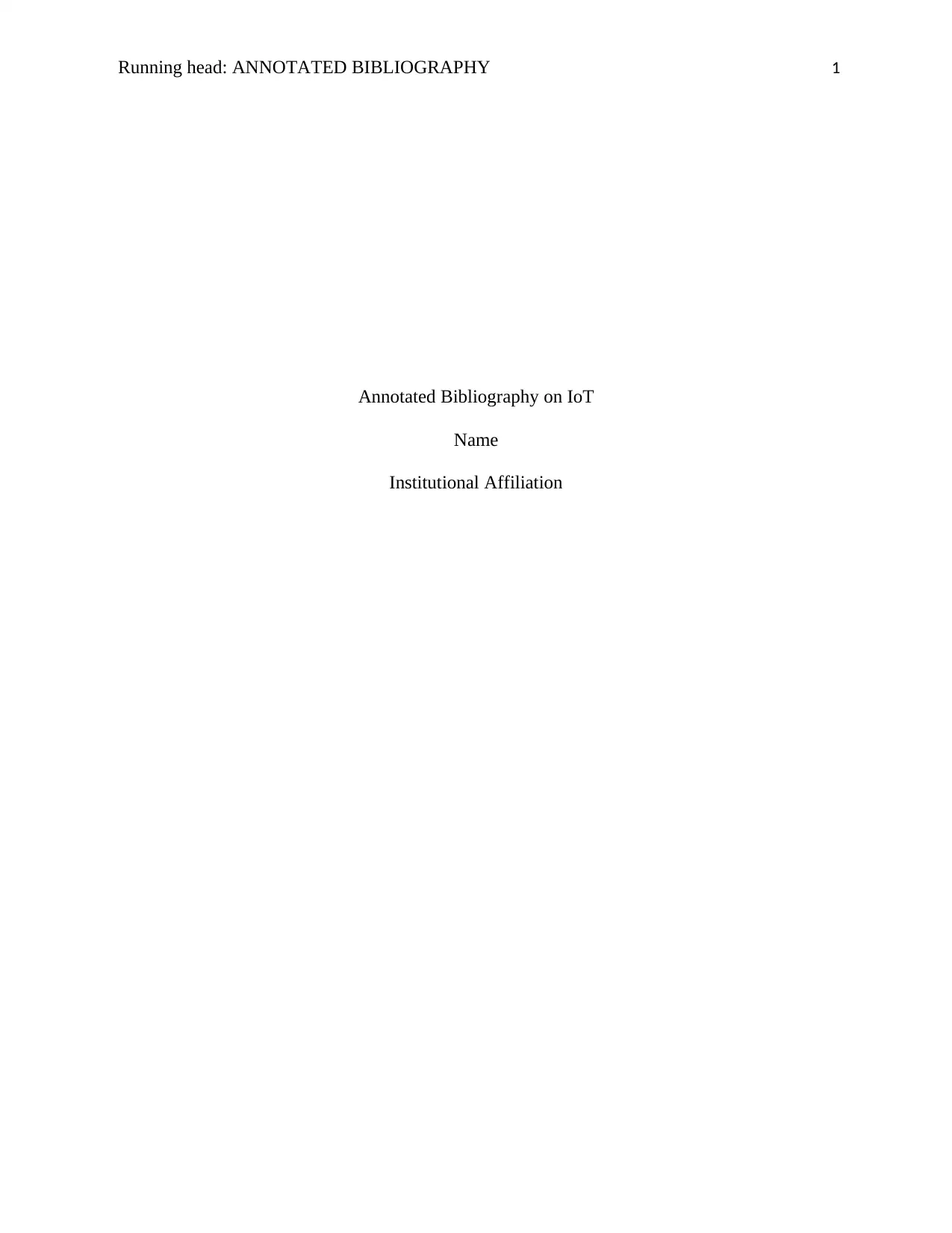
Running head: ANNOTATED BIBLIOGRAPHY 1
Annotated Bibliography on IoT
Name
Institutional Affiliation
Annotated Bibliography on IoT
Name
Institutional Affiliation
Paraphrase This Document
Need a fresh take? Get an instant paraphrase of this document with our AI Paraphraser
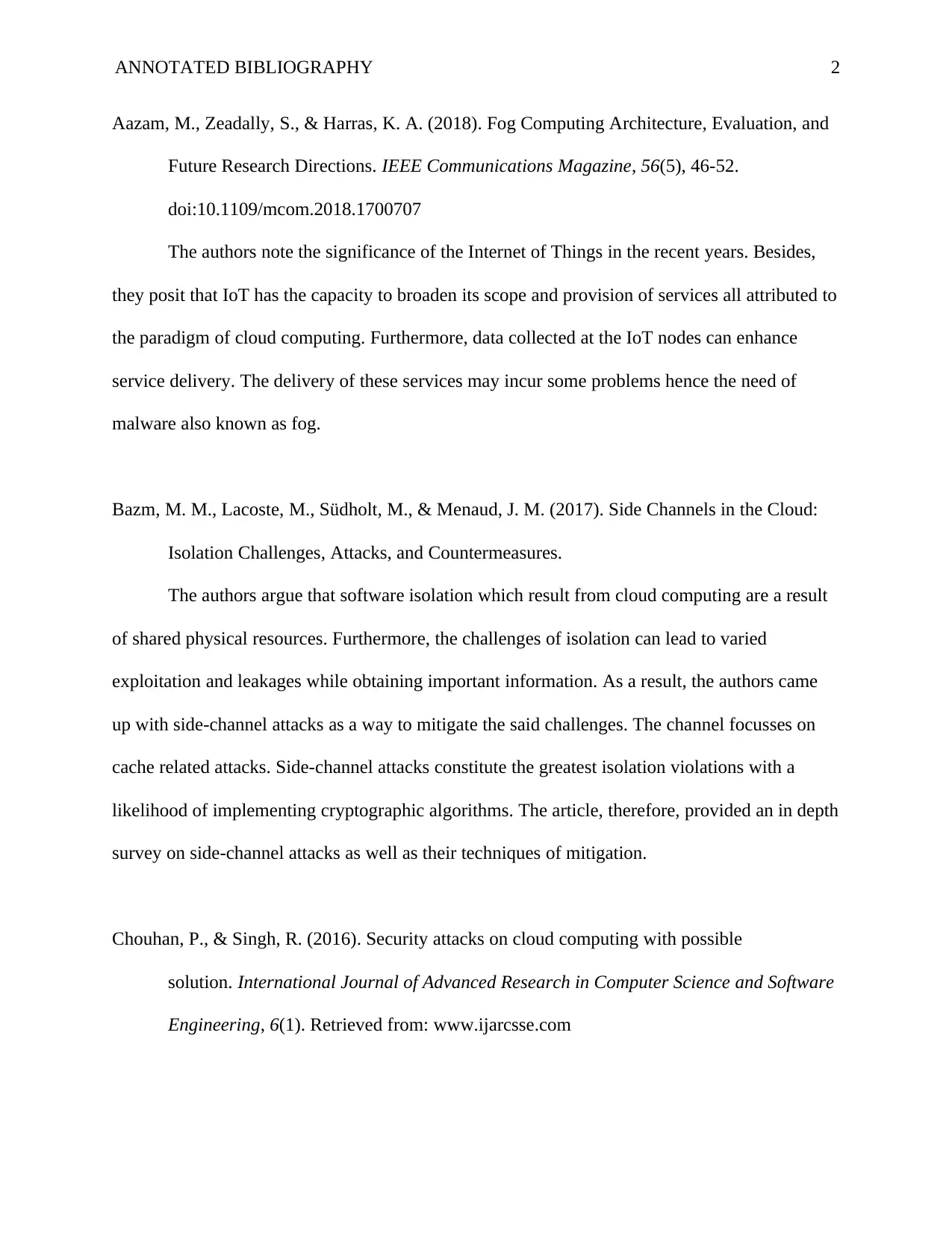
ANNOTATED BIBLIOGRAPHY 2
Aazam, M., Zeadally, S., & Harras, K. A. (2018). Fog Computing Architecture, Evaluation, and
Future Research Directions. IEEE Communications Magazine, 56(5), 46-52.
doi:10.1109/mcom.2018.1700707
The authors note the significance of the Internet of Things in the recent years. Besides,
they posit that IoT has the capacity to broaden its scope and provision of services all attributed to
the paradigm of cloud computing. Furthermore, data collected at the IoT nodes can enhance
service delivery. The delivery of these services may incur some problems hence the need of
malware also known as fog.
Bazm, M. M., Lacoste, M., Südholt, M., & Menaud, J. M. (2017). Side Channels in the Cloud:
Isolation Challenges, Attacks, and Countermeasures.
The authors argue that software isolation which result from cloud computing are a result
of shared physical resources. Furthermore, the challenges of isolation can lead to varied
exploitation and leakages while obtaining important information. As a result, the authors came
up with side-channel attacks as a way to mitigate the said challenges. The channel focusses on
cache related attacks. Side-channel attacks constitute the greatest isolation violations with a
likelihood of implementing cryptographic algorithms. The article, therefore, provided an in depth
survey on side-channel attacks as well as their techniques of mitigation.
Chouhan, P., & Singh, R. (2016). Security attacks on cloud computing with possible
solution. International Journal of Advanced Research in Computer Science and Software
Engineering, 6(1). Retrieved from: www.ijarcsse.com
Aazam, M., Zeadally, S., & Harras, K. A. (2018). Fog Computing Architecture, Evaluation, and
Future Research Directions. IEEE Communications Magazine, 56(5), 46-52.
doi:10.1109/mcom.2018.1700707
The authors note the significance of the Internet of Things in the recent years. Besides,
they posit that IoT has the capacity to broaden its scope and provision of services all attributed to
the paradigm of cloud computing. Furthermore, data collected at the IoT nodes can enhance
service delivery. The delivery of these services may incur some problems hence the need of
malware also known as fog.
Bazm, M. M., Lacoste, M., Südholt, M., & Menaud, J. M. (2017). Side Channels in the Cloud:
Isolation Challenges, Attacks, and Countermeasures.
The authors argue that software isolation which result from cloud computing are a result
of shared physical resources. Furthermore, the challenges of isolation can lead to varied
exploitation and leakages while obtaining important information. As a result, the authors came
up with side-channel attacks as a way to mitigate the said challenges. The channel focusses on
cache related attacks. Side-channel attacks constitute the greatest isolation violations with a
likelihood of implementing cryptographic algorithms. The article, therefore, provided an in depth
survey on side-channel attacks as well as their techniques of mitigation.
Chouhan, P., & Singh, R. (2016). Security attacks on cloud computing with possible
solution. International Journal of Advanced Research in Computer Science and Software
Engineering, 6(1). Retrieved from: www.ijarcsse.com
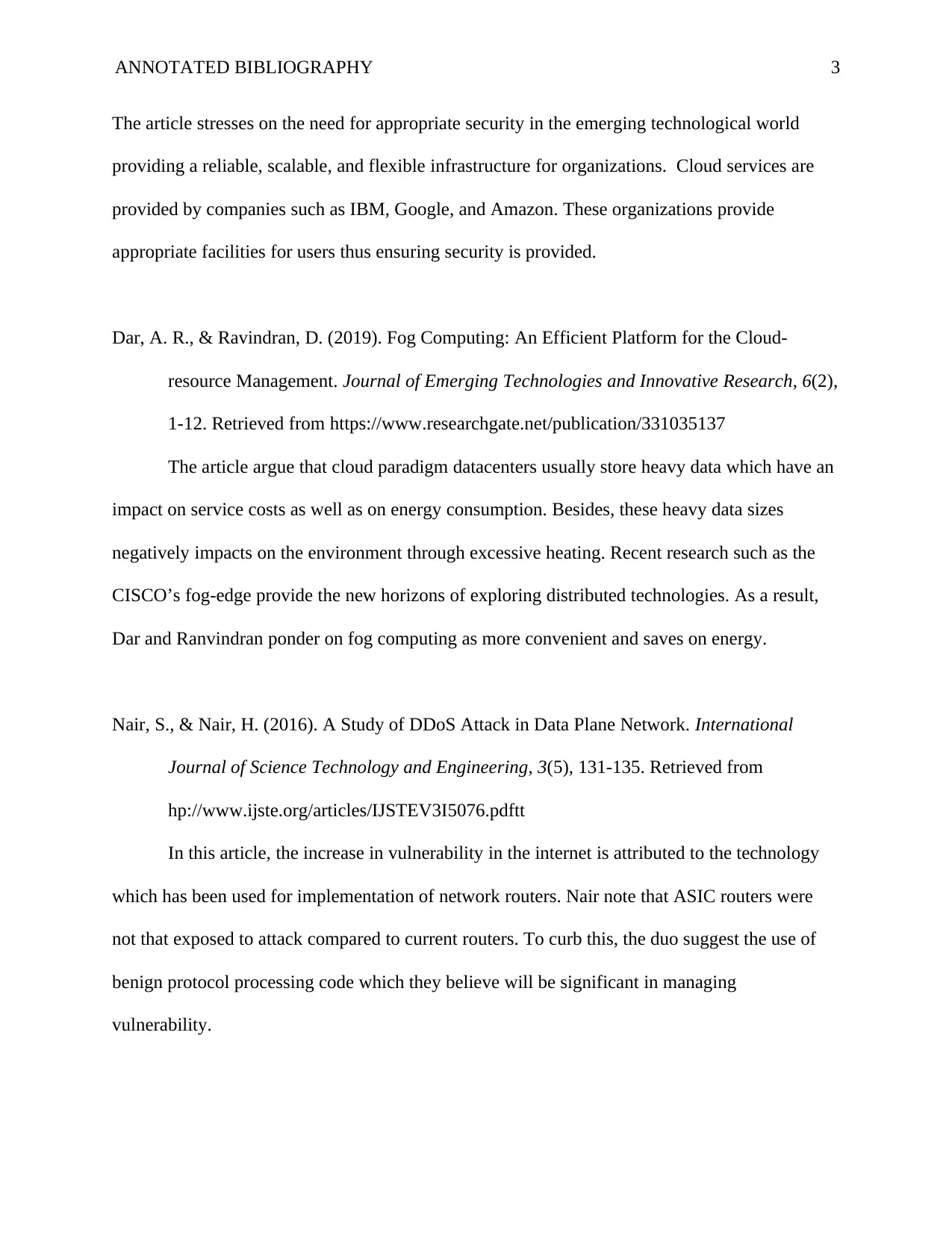
ANNOTATED BIBLIOGRAPHY 3
The article stresses on the need for appropriate security in the emerging technological world
providing a reliable, scalable, and flexible infrastructure for organizations. Cloud services are
provided by companies such as IBM, Google, and Amazon. These organizations provide
appropriate facilities for users thus ensuring security is provided.
Dar, A. R., & Ravindran, D. (2019). Fog Computing: An Efficient Platform for the Cloud-
resource Management. Journal of Emerging Technologies and Innovative Research, 6(2),
1-12. Retrieved from https://www.researchgate.net/publication/331035137
The article argue that cloud paradigm datacenters usually store heavy data which have an
impact on service costs as well as on energy consumption. Besides, these heavy data sizes
negatively impacts on the environment through excessive heating. Recent research such as the
CISCO’s fog-edge provide the new horizons of exploring distributed technologies. As a result,
Dar and Ranvindran ponder on fog computing as more convenient and saves on energy.
Nair, S., & Nair, H. (2016). A Study of DDoS Attack in Data Plane Network. International
Journal of Science Technology and Engineering, 3(5), 131-135. Retrieved from
hp://www.ijste.org/articles/IJSTEV3I5076.pdftt
In this article, the increase in vulnerability in the internet is attributed to the technology
which has been used for implementation of network routers. Nair note that ASIC routers were
not that exposed to attack compared to current routers. To curb this, the duo suggest the use of
benign protocol processing code which they believe will be significant in managing
vulnerability.
The article stresses on the need for appropriate security in the emerging technological world
providing a reliable, scalable, and flexible infrastructure for organizations. Cloud services are
provided by companies such as IBM, Google, and Amazon. These organizations provide
appropriate facilities for users thus ensuring security is provided.
Dar, A. R., & Ravindran, D. (2019). Fog Computing: An Efficient Platform for the Cloud-
resource Management. Journal of Emerging Technologies and Innovative Research, 6(2),
1-12. Retrieved from https://www.researchgate.net/publication/331035137
The article argue that cloud paradigm datacenters usually store heavy data which have an
impact on service costs as well as on energy consumption. Besides, these heavy data sizes
negatively impacts on the environment through excessive heating. Recent research such as the
CISCO’s fog-edge provide the new horizons of exploring distributed technologies. As a result,
Dar and Ranvindran ponder on fog computing as more convenient and saves on energy.
Nair, S., & Nair, H. (2016). A Study of DDoS Attack in Data Plane Network. International
Journal of Science Technology and Engineering, 3(5), 131-135. Retrieved from
hp://www.ijste.org/articles/IJSTEV3I5076.pdftt
In this article, the increase in vulnerability in the internet is attributed to the technology
which has been used for implementation of network routers. Nair note that ASIC routers were
not that exposed to attack compared to current routers. To curb this, the duo suggest the use of
benign protocol processing code which they believe will be significant in managing
vulnerability.
⊘ This is a preview!⊘
Do you want full access?
Subscribe today to unlock all pages.

Trusted by 1+ million students worldwide
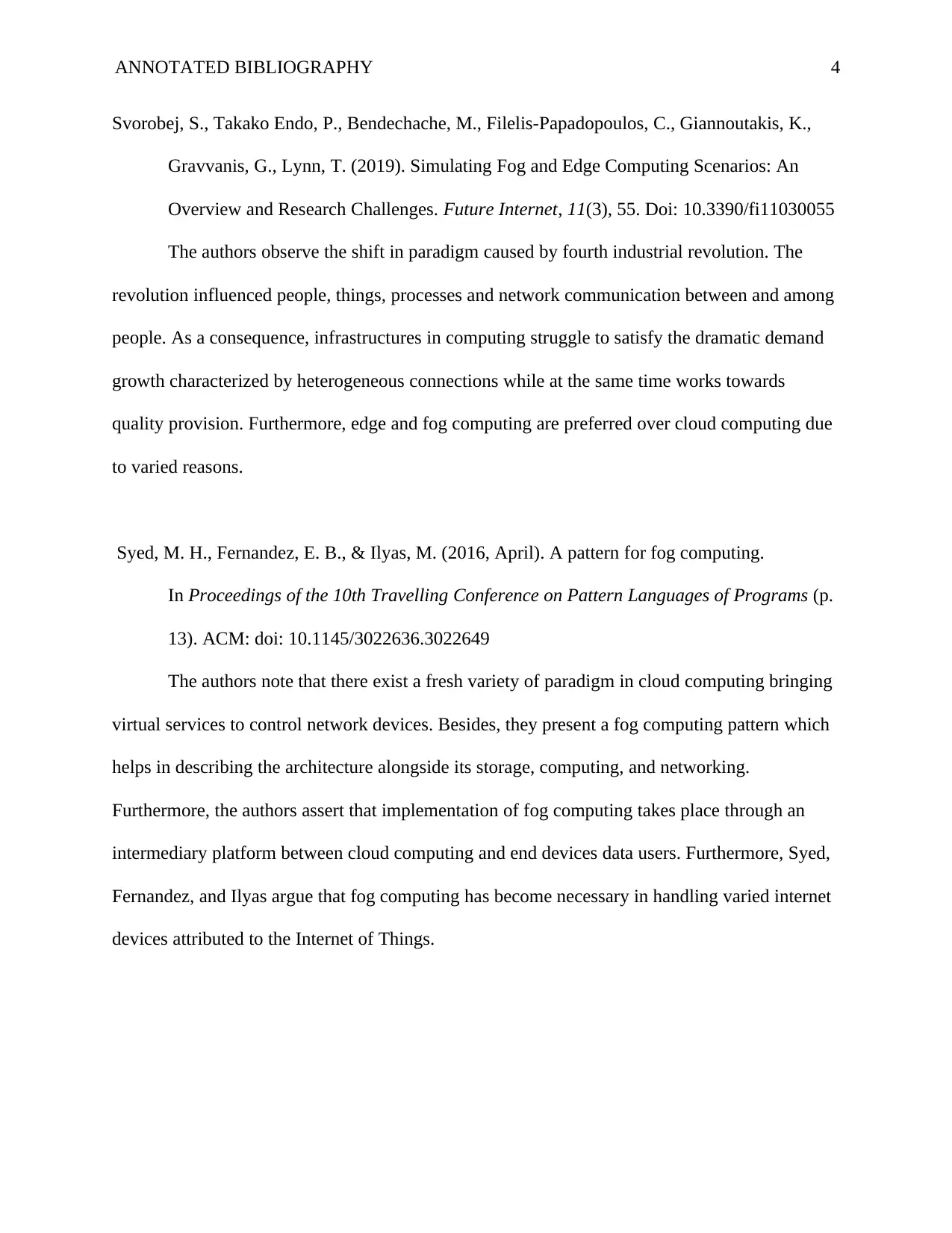
ANNOTATED BIBLIOGRAPHY 4
Svorobej, S., Takako Endo, P., Bendechache, M., Filelis-Papadopoulos, C., Giannoutakis, K.,
Gravvanis, G., Lynn, T. (2019). Simulating Fog and Edge Computing Scenarios: An
Overview and Research Challenges. Future Internet, 11(3), 55. Doi: 10.3390/fi11030055
The authors observe the shift in paradigm caused by fourth industrial revolution. The
revolution influenced people, things, processes and network communication between and among
people. As a consequence, infrastructures in computing struggle to satisfy the dramatic demand
growth characterized by heterogeneous connections while at the same time works towards
quality provision. Furthermore, edge and fog computing are preferred over cloud computing due
to varied reasons.
Syed, M. H., Fernandez, E. B., & Ilyas, M. (2016, April). A pattern for fog computing.
In Proceedings of the 10th Travelling Conference on Pattern Languages of Programs (p.
13). ACM: doi: 10.1145/3022636.3022649
The authors note that there exist a fresh variety of paradigm in cloud computing bringing
virtual services to control network devices. Besides, they present a fog computing pattern which
helps in describing the architecture alongside its storage, computing, and networking.
Furthermore, the authors assert that implementation of fog computing takes place through an
intermediary platform between cloud computing and end devices data users. Furthermore, Syed,
Fernandez, and Ilyas argue that fog computing has become necessary in handling varied internet
devices attributed to the Internet of Things.
Svorobej, S., Takako Endo, P., Bendechache, M., Filelis-Papadopoulos, C., Giannoutakis, K.,
Gravvanis, G., Lynn, T. (2019). Simulating Fog and Edge Computing Scenarios: An
Overview and Research Challenges. Future Internet, 11(3), 55. Doi: 10.3390/fi11030055
The authors observe the shift in paradigm caused by fourth industrial revolution. The
revolution influenced people, things, processes and network communication between and among
people. As a consequence, infrastructures in computing struggle to satisfy the dramatic demand
growth characterized by heterogeneous connections while at the same time works towards
quality provision. Furthermore, edge and fog computing are preferred over cloud computing due
to varied reasons.
Syed, M. H., Fernandez, E. B., & Ilyas, M. (2016, April). A pattern for fog computing.
In Proceedings of the 10th Travelling Conference on Pattern Languages of Programs (p.
13). ACM: doi: 10.1145/3022636.3022649
The authors note that there exist a fresh variety of paradigm in cloud computing bringing
virtual services to control network devices. Besides, they present a fog computing pattern which
helps in describing the architecture alongside its storage, computing, and networking.
Furthermore, the authors assert that implementation of fog computing takes place through an
intermediary platform between cloud computing and end devices data users. Furthermore, Syed,
Fernandez, and Ilyas argue that fog computing has become necessary in handling varied internet
devices attributed to the Internet of Things.
Paraphrase This Document
Need a fresh take? Get an instant paraphrase of this document with our AI Paraphraser
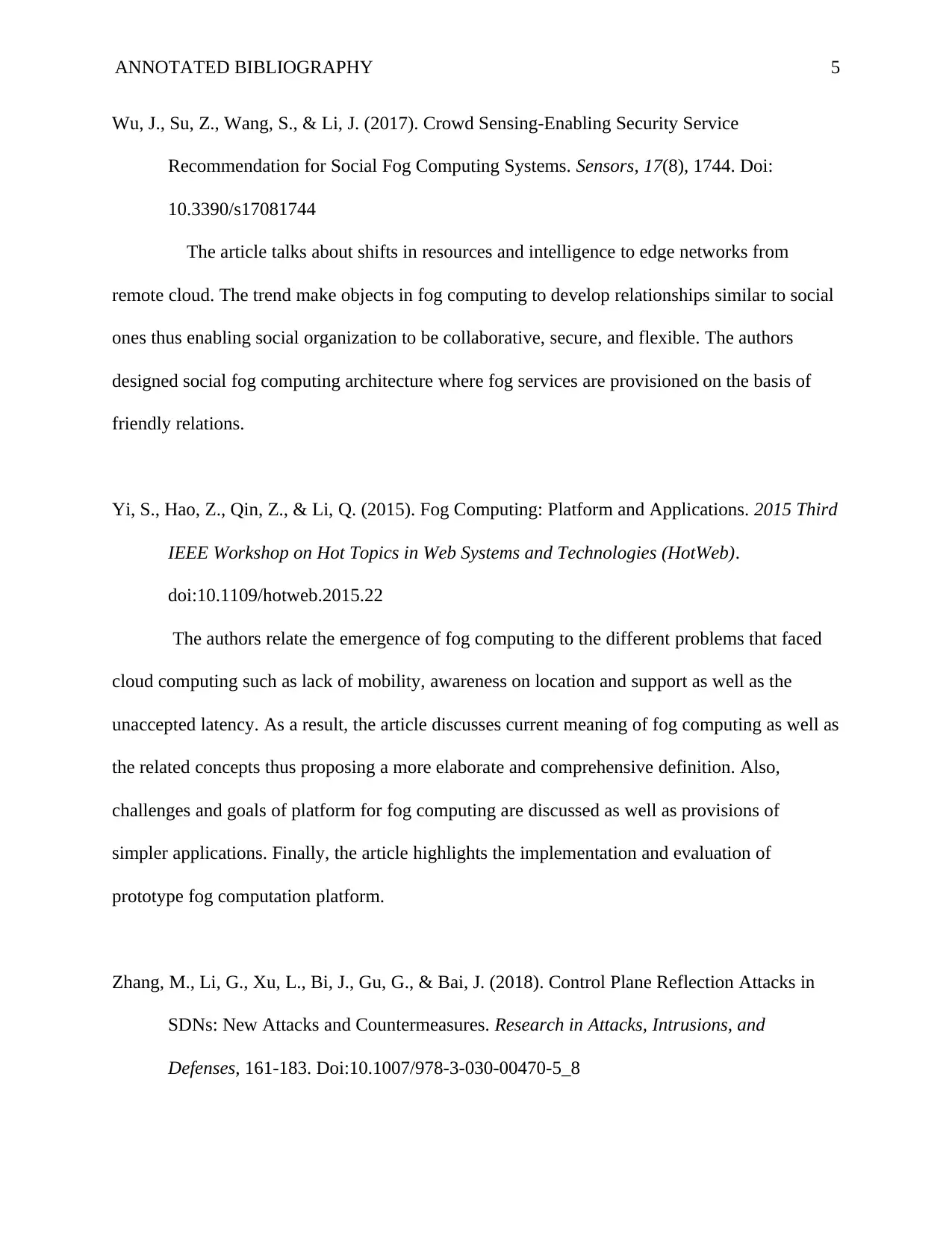
ANNOTATED BIBLIOGRAPHY 5
Wu, J., Su, Z., Wang, S., & Li, J. (2017). Crowd Sensing-Enabling Security Service
Recommendation for Social Fog Computing Systems. Sensors, 17(8), 1744. Doi:
10.3390/s17081744
The article talks about shifts in resources and intelligence to edge networks from
remote cloud. The trend make objects in fog computing to develop relationships similar to social
ones thus enabling social organization to be collaborative, secure, and flexible. The authors
designed social fog computing architecture where fog services are provisioned on the basis of
friendly relations.
Yi, S., Hao, Z., Qin, Z., & Li, Q. (2015). Fog Computing: Platform and Applications. 2015 Third
IEEE Workshop on Hot Topics in Web Systems and Technologies (HotWeb).
doi:10.1109/hotweb.2015.22
The authors relate the emergence of fog computing to the different problems that faced
cloud computing such as lack of mobility, awareness on location and support as well as the
unaccepted latency. As a result, the article discusses current meaning of fog computing as well as
the related concepts thus proposing a more elaborate and comprehensive definition. Also,
challenges and goals of platform for fog computing are discussed as well as provisions of
simpler applications. Finally, the article highlights the implementation and evaluation of
prototype fog computation platform.
Zhang, M., Li, G., Xu, L., Bi, J., Gu, G., & Bai, J. (2018). Control Plane Reflection Attacks in
SDNs: New Attacks and Countermeasures. Research in Attacks, Intrusions, and
Defenses, 161-183. Doi:10.1007/978-3-030-00470-5_8
Wu, J., Su, Z., Wang, S., & Li, J. (2017). Crowd Sensing-Enabling Security Service
Recommendation for Social Fog Computing Systems. Sensors, 17(8), 1744. Doi:
10.3390/s17081744
The article talks about shifts in resources and intelligence to edge networks from
remote cloud. The trend make objects in fog computing to develop relationships similar to social
ones thus enabling social organization to be collaborative, secure, and flexible. The authors
designed social fog computing architecture where fog services are provisioned on the basis of
friendly relations.
Yi, S., Hao, Z., Qin, Z., & Li, Q. (2015). Fog Computing: Platform and Applications. 2015 Third
IEEE Workshop on Hot Topics in Web Systems and Technologies (HotWeb).
doi:10.1109/hotweb.2015.22
The authors relate the emergence of fog computing to the different problems that faced
cloud computing such as lack of mobility, awareness on location and support as well as the
unaccepted latency. As a result, the article discusses current meaning of fog computing as well as
the related concepts thus proposing a more elaborate and comprehensive definition. Also,
challenges and goals of platform for fog computing are discussed as well as provisions of
simpler applications. Finally, the article highlights the implementation and evaluation of
prototype fog computation platform.
Zhang, M., Li, G., Xu, L., Bi, J., Gu, G., & Bai, J. (2018). Control Plane Reflection Attacks in
SDNs: New Attacks and Countermeasures. Research in Attacks, Intrusions, and
Defenses, 161-183. Doi:10.1007/978-3-030-00470-5_8
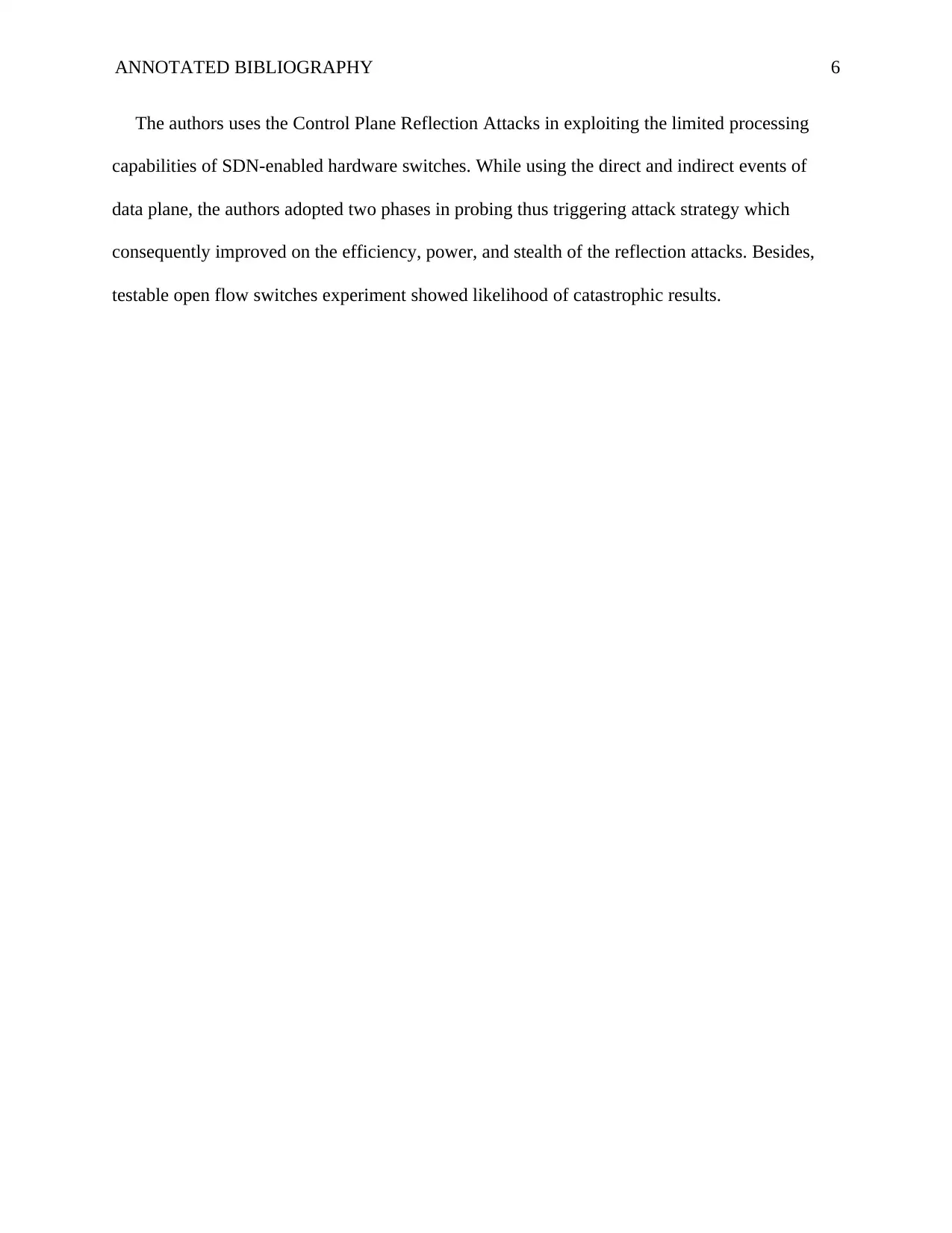
ANNOTATED BIBLIOGRAPHY 6
The authors uses the Control Plane Reflection Attacks in exploiting the limited processing
capabilities of SDN-enabled hardware switches. While using the direct and indirect events of
data plane, the authors adopted two phases in probing thus triggering attack strategy which
consequently improved on the efficiency, power, and stealth of the reflection attacks. Besides,
testable open flow switches experiment showed likelihood of catastrophic results.
The authors uses the Control Plane Reflection Attacks in exploiting the limited processing
capabilities of SDN-enabled hardware switches. While using the direct and indirect events of
data plane, the authors adopted two phases in probing thus triggering attack strategy which
consequently improved on the efficiency, power, and stealth of the reflection attacks. Besides,
testable open flow switches experiment showed likelihood of catastrophic results.
⊘ This is a preview!⊘
Do you want full access?
Subscribe today to unlock all pages.

Trusted by 1+ million students worldwide
1 out of 6
Related Documents
Your All-in-One AI-Powered Toolkit for Academic Success.
+13062052269
info@desklib.com
Available 24*7 on WhatsApp / Email
![[object Object]](/_next/static/media/star-bottom.7253800d.svg)
Unlock your academic potential
Copyright © 2020–2025 A2Z Services. All Rights Reserved. Developed and managed by ZUCOL.





